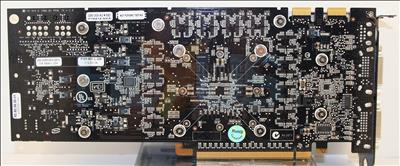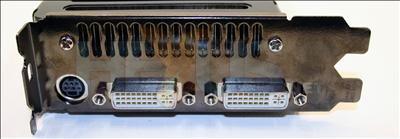GeForce 8800 GTX Reference Board Exam
We'll get it out of the way now: GeForce 8800 GTX boards are big. Longer-than-X1900-All-In-Wonder big. Longer than any other programmable GPU-based board ever released onto the consumer market big. However, that's not to say they're so big you'll need a new case to fit yours in. You might, but depending on the box you have you might be perfectly fine. Here's the board in pics, so you can peek.Say hello to 267x98.5mm of PCB. It says hello back. The entire board assembly weighs some 740g, consumes two backplane slots and slides into a PCI Express x16 slot on any mainboard that supplies it. Two 6-pin power connectors are required (it screams at you on bootup with just one) as you can see, and the board provides two SLI connectors for a brand new technology that NVIDIA calls "No comment", but which we think we'll call "connecting more than two together".
The cooler is very effective, the rotary blower-style fan pushing air across the heatsink mass (which comprises a sizeable copper element, aluminium fins, a fat heatpipe and a shroud to direct airflow) and out of your chassis via the backplane. It's not quite as quiet in 3D mode as a GeForce 7900 GTX (or GeForce 7800 GTX 512 for that matter), but it will be drowned out by the noise of the rest of the system for most people. We'd estimate less than 40dBA at full speed, if we had to make an informed guess, and we'll bust out the SPL meter as soon as we get the chance.
What you can't see without the cooler off (and we haven't got nudes for you just yet, but check out hardware.fr because we have a hunch Damien has some) is the enormous chip package for G80, which comes replete with heatspreader and big shim around the 'spreader's border. The DRAMs then surround that, Samsung's highest rated 900MHz GDDR3 doing business for the 8800 GTX, those 12 devices adding up to a 768MiB total VRAM space on that 384-bit bus the G80 waves around in full configuration.
You also can't see the previously discussed NVIO processor, responsible for sitting in front of the G80 GPU and doing all of its analogue and digital signal I/O. It's a small chip (only 49mm²) and built using TSMC's 110nm process it's actively cooled by the main cooler assembly. It drives a pair of DVI ports (shown soon) that carry dual-link DVI and analogue signals for display output, along with an output port that supports analogue component output and S-Video as well.
The two power connectors hint at ungodly power consumption, but the reality is that the 2nd one is for those peaky moments when 75W over the slot and 75W from the 1st connector aren't quite enough. The entire board is capable of asking for more than 150W during 3D operation, but we measure just over 210W idle using the test system on the following page (at the wall so for the entire test PC not just the graphics board, using UK mains supply), and ~310W average under load (at the wall again).
Mind my grubby finger prints.
As far as sliding it into a chassis, your reviewer had zero problems finding room in an Akasa Eclipse-62, even with the HDD bays near where the end of the board is full to the brim with disks. There's over an inch of room between board and disk in that configuration and that chassis. Another Coolermaster chassis we have is also fine, but the gap between the board end and the disk bays is much smaller and we're thankful that the power connectors are where they are, rather than in the traditional place leading out of the board's far edge.
0.000165906108 miles is a long way, but that doesn't mean it's an impossible fit.
Double-wide is joined by almost-double-long, but the cooling solution's performance and the knowledge that you don't need your own electrical substation to power the next generation of high-end graphics hardware (see what we used when you turn the page) is enough for us to give the thumbs up to the form factor, at least as far as the target market goes. Take your ruler and see if you have 267mm/26.7cm/10.5 inches of free space from the backplane (and over your mainboard, since it'll hang over the edge of a 9-hole ATX 'board) and if you do, sweet.
The test system is next, then we move on to how good it can make pixels look.















